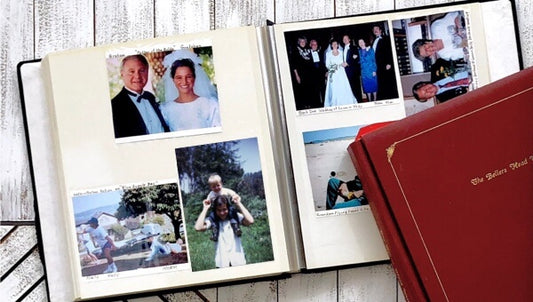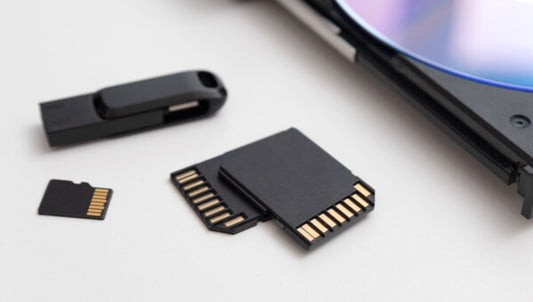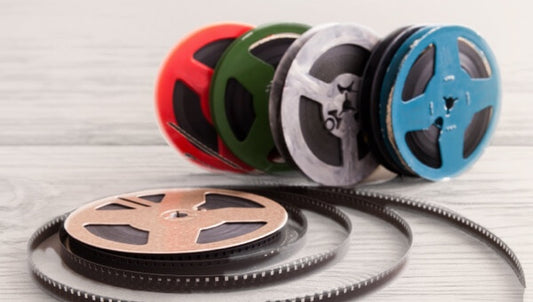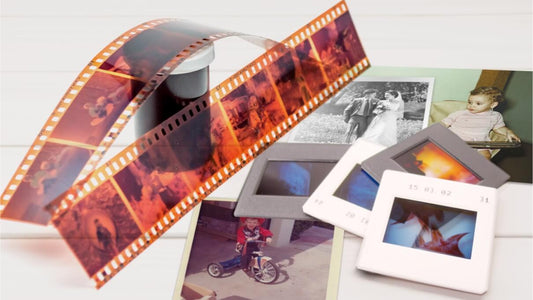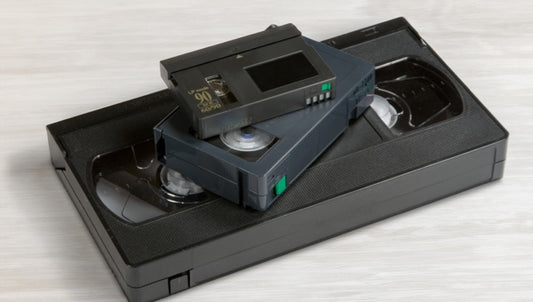For years, VHS tapes were the most popular choice for capturing home movies as well as watching Hollywood and Disney classics, getting video rentals, and documenting history. But when was VHS invented and how did it become an integral part of what was popular in the 80s, 90s, and into the 2000s?
Since the days when VHS was still popular, Capture has been helping families update to the digital age by preserving their home movies, film reels, and photos as high-quality digital heirlooms. Our experts put together this VHS timeline and history to document those days and preserve the history of analog videotapes just like we preserve memories.
Keep reading to learn about VHS origins and inventions, the format war and battle between Betamax and VHS, the main innovators and milestones of VHS technology, and the decline of the format we all loved.
Jump to:
- A Trip Down Memory Lane: The Birth of VHS
- The Key Players: VHS Inventors
- Invention Milestones: The Evolution of VHS
- A Cultural Phenomenon: VHS Takes the World by Storm
- Legacy and Obsolescence: The Decline of VHS
A Trip Down Memory Lane: The Birth of VHS

Before the 1970s, long after the first video was recorded, capturing home movies required Super 8 film or other film formats, but it was clear that a change to an easier, higher quality, and more affordable format was a necessary step. After all, Hollywood had already been using magnetic tape since the 1950s. The only problem was that it wasn’t affordable or user-friendly for everyday use.
But during the early 70s, new formats began to develop alongside the rise of JVC, the Victor Company of Japan. They released U-Matic tapes in 1971 that acted as the predecessor to VHS, but other companies like Sony were also developing new videotape formats. In fact, Sony Betamax would be the primary rival of VHS tapes later in the decade leading to the VHS vs Beta format war.
Then, using similar technology used in Ampex VCR recorders around the same time 8-track tapes came out in the 1960s, JVC released the VHS format in Japan in 1976 and the United States in 1977. That means that both 1976 and 1977 can technically be the answer to, “When was VHS invented?” However, the most precise answer to the question is 1976.
The Key Players: VHS Inventors

If you’re wondering what VHS stands for, it generally refers to Video Home System, but actually began as an abbreviation for Vertical Helical Scan, which refers to the magnetic tape-recording system developed by JVC.
The process that led to the invention of VHS began back in 1969 when JVC collaborated with Sony Corporation and Matsushita Electric (that later became Panasonic) to build a video recording standard for Japanese consumers. This is what led to the U-Matic, the first cassette format.
However, when the companies broke up, they all began to develop their own formats. Sony would work on Betamax tapes while Matsushita forked on VHS. JVC began working on the VHS format and released the CR-6060 in 1975.
JVC engineers Yuma Shiraishi and Shizuo Takano compiled a team to develop a Video Tape Recorder, or VTR, for customers. By the end of 1971, they had created an internal diagram, the VHS Development Matrix, that detailed many objectives for the VHS tape format that was to be invented only 5 years later.
These goals included a system compatible with a normal television set, air broadcast picture quality, at least 2-hour recording time, and affordability. By 1973, they had created a functional VHS cassette prototype leading directly to when was VHS invented in 1976 and the North America and U.S. release in 1977.
At the same time, Sony was also developing the Betamax home motion picture format. The Betamax format offered a higher quality picture in a more compact cassette, but JVC decided that open standard and VHS video format sharing was the correct approach. This made it more affordable, more available, and more widely distributed by companies like Sharp, Philips, and more. This likely led directly to the adoption of VHS tapes as the go-to format.
Invention Milestones: The Evolution of VHS

The invention of the VHS is only part of the history of VHS. The truth is that VHS machines revolutionized home recording. When the first VCR came out, it finally made it affordable and easy to watch movies at home while also being able to rewind, pause, and fast-forward.
The first VHS VCR, or Video Cassette Recorder, was the Victor HR-3300 which was released in 1976, but the first in the United States was the RCA VBT200. Additionally, the first video camera was invented for VHS tapes in the early 80s along with the new VHS-C or compact VHS movies.
Because they were smaller, how to watch VHS-C tapes became easier while recording them became a family-friendly process. For the first time, it was extremely easy to use blank tapes to watch, record, and re-watch their family gatherings, graduations, weddings, holidays, and other events.
Other types of VHS tapes were also released including the higher quality Super VHS, or S-VHS. Then, a Super Compact VHS tape was also released, known as the S-VHS-C, marking the pinnacle of VHS tape technology.
These advancements and the fact that VHS players and tapes were more affordable and available than competing formats meant that the old video camera, home recording, and movie-watching format dominated the market share for the next 15 years or so.
A Cultural Phenomenon: VHS Takes the World by Storm

If you watched old Disney movies, horror movies from the early 1980s, classic action films, or your own home movies during the 80s or 90s, there’s an excellent chance that you watched them on old VHS tapes. That’s because it was by far the most popular home entertainment format and home movie playback.
It also led to the rise of rental stores like Blockbuster. While these rental stores are now a relic of the past, for over a decade they were a cornerstone in culture, and going to pick out a couple of movies on a Friday night became a popular activity across the world.
People began to amass huge collections of VHS cassette tapes, and any major movie release would come out on VHS. However, the digital age was coming with the first digital cameras coming in the early and mid-1990s. Pretty soon, people began to convert from VHS to digital format as new formats were being introduced.
Legacy and Obsolescence: The Decline of VHS

When DVD came out in Japan in 1996 and the United States in 1997, it was clear that the end of VHS was in sight. While the last VHS movie wasn’t made until a few years later, DVD, and later Blu-Ray, began to dig into the VHS home use format market share before the turn of the millennium. The VHS format was on the way out while the digital age took over.
Unlike VHS, DVD players offered digital audio and picture quality, a more compact design, the ability to skip to chapters, interactive features, and a larger storage capacity. While many people stuck with the VHS format for a few years, it was a losing battle, and the shift was already in motion.
That doesn’t mean that VHS tapes are forgotten though. People still associate the videotape format with nostalgia and the family memories captured on VHS still hold sentimental value. However, VHS tapes won’t last forever, so sooner or later it’s important to digitize home movies captured on VHS if you don’t want to lose them forever.
Conclusion
Now, if a friend asks, “When was VHS invented?” you can give them a detailed answer about how it was released in Japan in 1976 and how VHS inventors revolutionized home recording technology and paved the way for future digital formats. Just make sure that your nostalgia doesn’t cloud your logic and make you keep VHS tapes without digital copies because they will only last so long before losing data and wearing out.
If you have old VHS tapes lying around, Capture can convert them to high-quality digital format and upload them to your Google Photos library for an affordable price. Click here to learn about our video transfer services!





